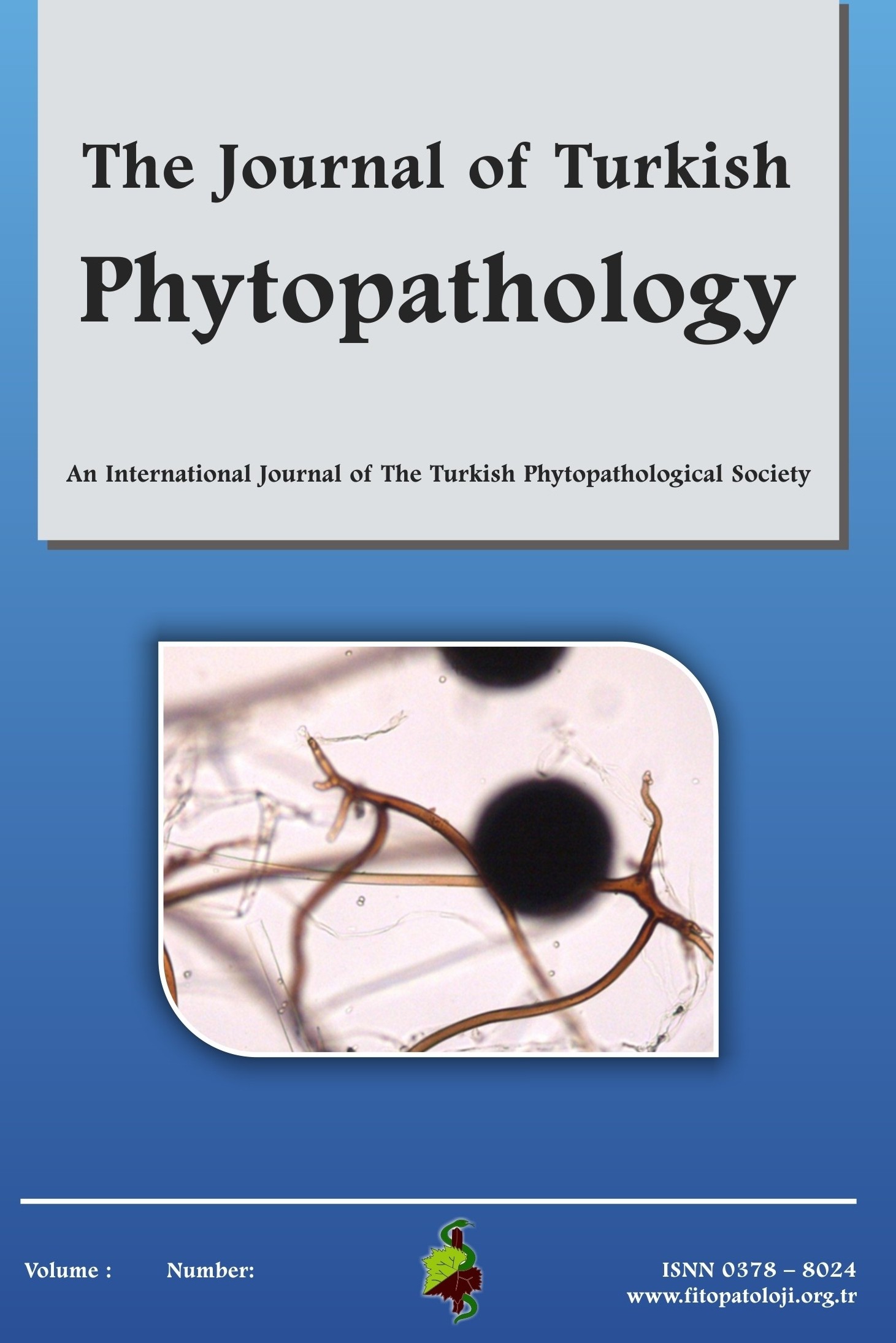Kökboğazı Çürüklüğü (Macrophomina Phaseolina ), Sulama ve Ekim Zamanının Bazı Susam Hatlarının Yağ ve Protein İçerikleri Üzerine Etkisi
-
Anahtar Kelimeler:
-
The Effect of Charcoal Rot Disease (Macrophomina phaseolina), Irrigation and Sowing Date on Oil and Protein Content of Some Sesame Lines
This study was conducted to determine the effect of charcoal rot disease (Macrophomina phaseolina) on oil and protein content of some sesame lines cultivated under different conditions at the experimental area of Dicle University Faculty of Agriculture, in 2006 and 2007. In this study, 6 sesame lines (B–60, C–7, C–36, C–53, Y–7 and Y–11) which are of Mediterranean and Southeastern Anatolia Region origin and 3 isolates which belong to the M. phaseolina fungus are treated. Before sowing, experimental area was inoculated artificially by disease factor. Sesame seeds were sown on 05 May 2006, 22 June 2006, 11 May 2007 and 22 June 2007, respectively. The experiment was established in a split-split plot design with three replications. At crop maturity, unhealthy and healthy plants on each plot were harvested separately, and adequate amount of seed samples were taken. In both years, the seeds from each plot were taken after harvest for determining oil and protein content. Average protein and oil content were recorded as 23.18% and 45.48%, respectively. Protein and oil contents were affected by sowing date, irrigation and disease. According to the obtained data, protein content of seeds obtained from unhealthy plants was found lower when compared to the healthy plants, and oil content was found higher. The highest protein content obtained from early sowing, dry conditions and healthy plants (25.99%), and the lowest content from late sowing, irrigated and unhealthy plants (20.64%). The highest oil content obtained from early sowing, irrigated and unhealthy plants (46.54%) and the lowest oil content from early sowing, irrigated and healthy plant (44.70%)
Keywords:
Sesame, protein, oil, sowing date, irrigation, charcoal rot disease Macrophomina phaseolina,
___
- Alyemeni, M. N., A. Y. Basahy and H. Sher, 2011. Physico-Chemical Analysis and Mineral Composition of Some Sesame Seeds (Sesamum indicum L.) Grown in The Gizan Area of Saudi Arabia. Journal of Medicinal Plants Research, 5(2): 270-274.
- Anonim 2010. Türkiye İstatistik Kurumu. Bitkisel Üretim İstatistikleri Veri Tabani.www.tuik.gov.tr
- AOAC, 1960. Official Methods of Analysis. Association of Official Agricultural Chemistry, Washington, D.C.
- Arıoğlu, H., Ö. Kolsarıcı, A. Tanju Göksu, L. Güllüoğlu, M. Arslan, S. Çalışkan T.Söğüt, C. Kurt Ve F. Arslanoğlu, 2010. Yağ Bitkileri Üretiminin Artırılması Olanakları. TMMOB Ziraat Mühendisleri Odası, Ziraat Mühendisliği Teknik Kongresi Bildiriler Kitabı-1,11-15 Ocak 2010 Ankara. S.361-376. Kitap sayfası 578
- Ataç A., Çetin V. ve İpkin B., 1994. Akdeniz Bölgesinde Susamlarda Kök ve Kökboğazı Çürüklüğü Hastalıkları. Bitki Koruma Bülteni, 34(1-2): 49-54.
- Atakişi, İ.K.,1985.Yağ Bitkileri Yetiştirme ve Islahı. Ç:Ü:Z:F: Ders Notu Yayınları 47, Adana,120 s.
- Bahkali, H., M. A. Hussain and A. Y. Basahy, 1998. Protein and Oil Composition of Sesame Seeds (Sesamum indicum, L.) Grown in the Gizan area of Saudi Arabia. International Journal of Food Sciences and Nutrition, 49(6): 409 414.
- Baydar, H. Ve İ.Turgut, 1994. Farklı Ekim Zamanlarının Susam (Sesamum indicum L.)’da Yağ Oranı, Yağ Aitleri Kompozisyonu ve Yağ Stabilite Kriterleri Üzerine Etkisi. Turkish Journal of Agricultural and Foresty, 18:387-391.
- Baydar, H., 2005. Susamda (Sesamum indicum L.) Verim, Yağ, Oleik ve Linoleik Tipi Hatların Tarımsal ve Teknolojik Özellikleri. Akdeniz Üniversitesi Ziraat Fakültesi Dergisi, 18(2): 267-272.
- Baydar, H., İ. Turgut, K. Turgut, 1999. Variation of Certain Characters and Line Selection for Yield, Oil, Oleic and Linoleic Acids in the Turkish Sesame (Sesamum indicum L.) Populations. Turkish Journal of Agriculture and Forestry, 23: 431-441.
- Diourte M,, Star S. J., Jeger M. J., Stack J. P. and Rosenow D. T. 1995. Charcoal Rot (Macrophomina phaseolina) Resistance and the Effect of Water Stres on Disease Development in Sorghum. Plant Pathology, 44: 196-202.
- Gürkan M., 1995. Diyarbakır ve Şanlıurfa İllerindeki Susam Ekim Alanlarında Görülen Fungal Hastalıkların Belirlenmesi Üzerine Araştırmalar. Yüksek Lisans Tezi, Gaziosmanpaşa Üniversitesi Fen Bilimleri Enstitüsü, Tokat, 35 s.
- Kanu, P. J. 2011. Biochemical Analysis of Black and White Sesame Seeds from China. American Journal of Molecular Biology, 1: 145-157.
- llisulu, K., 1973. Yağ Bitkileri ve Islahı. Çağlayan Kitap evi, İstanbul, 366 s.
- Mosjidis, J. A. and D. M. Yermanos, 1984. Plant Position Effect on Seed Weight, Oil Content, and Oil Composition in Sesame. Euphytica, 33 (2): 427-432.
- El Khier, N. K. S., K. E. A. Ishag and A. A. Y. El Gasim, 2008. Chemical Composition and oil Characteristics of Sesame Seed Cultivars Grown in Sudan. Research Journal of Agriculture and Biological Sciences, 4(6): 761 766.
- Nzikou, J. M., L. Matos, G. Bouanga-Kalou, C. B. Ndangui, N. P. G. Pambou- Tobi, A. Kimbongulia, Th. Silou, M. Linder and S. Desobry, 2009. Chemical Composition on the Seeds and Oil of Sesame (Sesamum indicum L.) Groen in Congo- Brazzaville. Advance Journal of Food Science and Technology 1(1): 6-11.
- Olaya G. and Abawi G. S. 1996. Effect of Water Potential on Micelial Growth and on Production and Germination of Scleratia of Macrophomina phaseolina. Plant Disease 80: 1347-1350.
- Sağır, P., A. Sağır ve T. Söğüt.,2009.Bazı Susam Hatlarının Kökboğazı Çürüklüğü Hastalığı (Macrophomina phaseolina )’na Karşı Reaksiyonları ve Hastalık Gelişiminin Belirlenmesi. HR.Ü. Z.F.Dergisi, 13(4):49-56.
- Tatlı, F. ve A. Sağır 1992. Güneydoğu Anadolu Bölgesi’nde İkinci Ürün Mısır, Susam ve Soya’ da Görülen Bazı Fitopatolojik Sorunlar. Güneydoğu Anadolu Bölgesi’nde İkinci Ürün Tarımı ve Sorunları Sempozyumu. 26- 29 Ekim 1992, Şanlıurfa.
- Uzun, B., S. Ülger, M. İ. Çağırgan, 2002. Comparison of Determinate and Indeterminate Types of Sesame for Oil Content and Fatty Acid Composition. Turk J. Agric For 26: 269-274.
- Ünal, M. K. and H. Yalçın, 2008. Proximate composition of Turkish Sesame Seeds and Characterization of Their Oils. Grasas y Aceites, 59 (1): 23-26.
- ISSN: 0378-8024
- Yayın Aralığı: Yılda 3 Sayı
- Başlangıç: 1971
- Yayıncı: Türkiye Fitopatoloji Derneği
